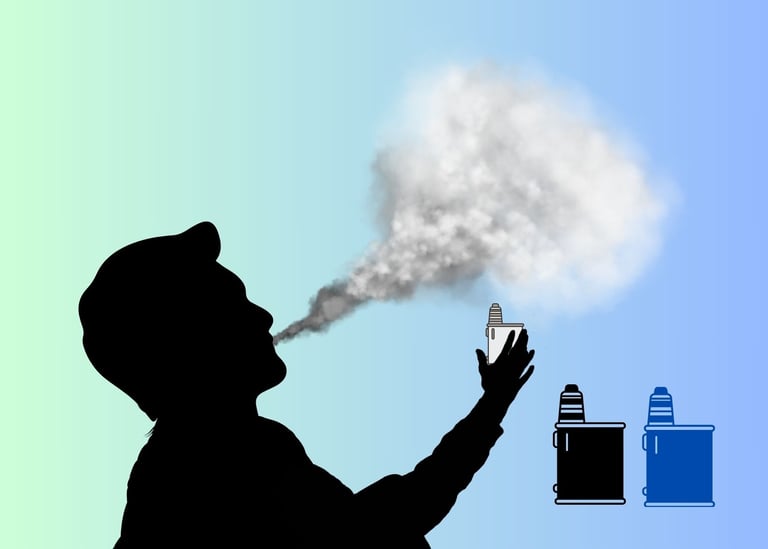Stay updated on what is trending in health. Discover tips and resources for a healthier, balanced life.
Popcorn Lung and Vaping: What You Need to Know About This Dangerous Connection
What is popcorn lung? Learn the causes, symptoms, and how vaping and chemical exposure can lead to this serious lung disease. Find out how to protect yourself today.
DISEASES AND CONDITIONS
Dr. S. Ali
8/16/20254 min read


You’ve probably heard the term "popcorn lung" floating around—especially in the news about vaping or flavored microwave popcorn. The name sounds a bit strange, right? But don’t be fooled. This condition is no snack-time joke.
You’ve also probably heard that vaping is safer than smoking—but is it really? One condition that’s raised major red flags is popcorn lung, a rare but serious lung disease that’s been linked to chemicals found in some e-cigarette flavors.
While the name might sound harmless (or even funny), popcorn lung is no joke—and if you vape, you need to know the risks.
So, what exactly is popcorn lung, and should you really be worried about it? Let’s break it down in plain, everyday language.
What is Popcorn Lung?
Popcorn lung is the nickname for a serious condition called bronchiolitis obliterans. It’s a rare and irreversible lung disease that damages the smallest airways in your lungs—called bronchioles—making it hard to breathe.
The quirky name comes from a group of workers at a microwave popcorn plant who developed the disease after being exposed to diacetyl, a buttery-flavored chemical once used in popcorn flavoring. So yes, it really does have something to do with popcorn.
What Causes Popcorn Lung?
While diacetyl is the most famous culprit, it’s not the only one. Popcorn lung can be caused by many factors. They are:
Inhalation of harmful chemicals, especially diacetyl, which was also found in some e-cigarette and vape liquids.
Fumes from industrial cleaning agents or metalworking chemicals
Respiratory infections like pneumonia or bronchitis
Certain medications or organ transplants (in rare cases)
Is Vaping to Blame?
Here's where things get real. Some flavored e-liquids used in vaping were found to contain diacetyl. Although many brands claim to have removed it, not all do—especially unregulated products.
Even without diacetyl, vaping exposes your lungs to a cocktail of other potentially harmful chemicals, which could lead to inflammation and lung damage over time. While popcorn lung itself may be rare, the risks from vaping are real, and lung issues are on the rise among young users.
Signs and Symptoms
The symptoms of popcorn lung often mimic those of other respiratory conditions like asthma or chronic bronchitis. Watch out for:
Persistent dry cough
Shortness of breath, especially during physical activity
Wheezing
Fatigue
Tightness in the chest
These symptoms usually show up gradually, so it’s easy to ignore them—but don’t. If you vape or have been exposed to industrial fumes, pay attention to any changes in your breathing.
Can Popcorn Lung Be Treated?
Unfortunately, popcorn lung doesn’t have a cure—once the delicate airways in your lungs are scarred and narrowed, the damage is usually permanent. The lungs does do not fully heal. But here’s the good news: it can be managed, especially if caught early.
The goal of treatment is to ease your symptoms, slow the progression of the disease, and improve your quality of life. Depending on how severe the condition is, your doctor may recommend a few different options:
Steroids: These help reduce inflammation in your lungs and may provide some symptom relief, especially in the early stages. Think of them as calming the storm inside your airways.
Inhalers or oxygen therapy: Just like with asthma or COPD, bronchodilators and other inhaled medications can make it easier to breathe. In more advanced cases, supplemental oxygen may be needed to help your lungs get enough air.
Lung transplant: This is rare, but in very severe cases where lung function is dangerously low and other treatments aren’t helping, a transplant might be the only option.
The most important takeaway? Early diagnosis can make a huge difference. If you have a persistent cough, shortness of breath, or wheezing—especially if you’ve been vaping or exposed to industrial chemicals—don’t brush it off. Get checked out. The earlier you start treatment, the better your chances of maintaining lung function and avoiding serious complications.
How to Protect Yourself
When it comes to popcorn lung, prevention is your best defense. Since the damage is often irreversible, taking steps now to reduce your risk can go a long way in keeping your lungs healthy and strong.
Here’s how you can protect yourself:
Skip the vape—especially flavored or unregulated products
This is a big one. Many flavored e-liquids—especially those sold by unregulated or off-brand manufacturers—may contain harmful chemicals like diacetyl or others that haven’t been fully studied. Even if a label claims it's diacetyl-free, there’s no guarantee unless it’s from a reputable, tested source. The safest bet? Avoid vaping altogether, especially if you're doing it recreationally.Read labels and safety guidelines if you work with industrial chemicals
If you work in manufacturing, flavoring, or cleaning industries, make sure you're aware of the substances you're exposed to. Chemicals like diacetyl or acetaldehyde can be inhaled unknowingly if proper safety measures aren't in place. Always use personal protective equipment (PPE) like masks or respirators, and don’t hesitate to ask your employer about safety data sheets (SDS) for the materials you handle.Ensure proper ventilation in your work environment
Whether you’re working in a factory or simply using strong cleaning products at home, ventilation is crucial. Proper airflow reduces the concentration of airborne chemicals, making them less likely to harm your lungs. Crack open a window, use exhaust fans, or take breaks outdoors when dealing with fumes.Avoid inhaling popcorn fumes directly
Microwave popcorn isn’t off-limits, but don’t stick your face in the bag right after opening it! When it's hot and freshly opened, the steam may release small amounts of chemical flavorings like diacetyl (although most major brands have phased this out). Let it cool for a minute before digging in.
Bonus tip: Stay informed. As more research is done on e-cigarettes and chemical exposure, recommendations may evolve. Keeping up to date can help you make better health decisions in the long run.
Final Thoughts
Popcorn lung might sound like a punchline, but it’s a real condition with serious consequences. Whether you’re a popcorn lover, a vaper, or someone who works with chemicals, it’s worth knowing the risks. Breathing should never be taken for granted.
Sources:
Centers for Disease Control and Prevention (CDC)
https://www.cdc.gov/tobacco/basic_information/e-cigarettes/severe-lung-disease.htmlNational Institutes of Health (NIH) – MedlinePlus
https://medlineplus.gov/popcornlung.htmlAmerican Lung Association
https://www.lung.org/quit-smoking/e-cigarettes-vaping/popcorn-lungOccupational Safety and Health Administration (OSHA) – Diacetyl Information
https://www.osha.gov/diacetylJohns Hopkins Medicine
https://www.hopkinsmedicine.org/health/wellness-and-prevention/5-truths-you-need-to-know-about-vaping
Pulse Your Health
Empowering you to achieve your health goals.
Contact
© 2025. All rights reserved.
Disclaimer: The content on this website is for informational purposes only and is not medical advice. Always seek the advice of your physician or other suitably qualified healthcare professional for diagnosis, treatment and your health related needs.
